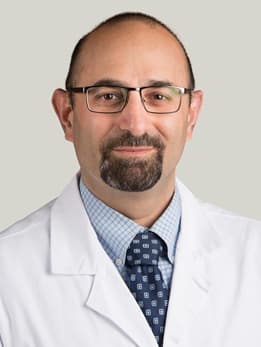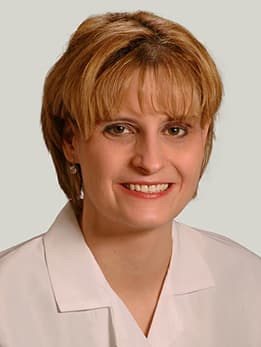Epilepsy Treatment

Comprehensive Approach, Individualized Epilepsy Treatment
As a Level 4 National Association of Epilepsy Centers (NAEC) epilepsy center, UChicago Medicine meets the highest standards for epilepsy treatment and care. We put our patients first when developing treatment plans, and our ultimate goal is to control or even cure your epilepsy. Whether your seizures are straightforward and easy to control or have a rare case, you can expect high-quality care from our expert team. When you come to us, you can expect treatment customized to your condition.
Epilepsy Surgery and Device Therapies
If your seizures cannot be controlled with medications, surgery may provide the best opportunity for you to achieve seizure freedom. At UChicago Medicine, we offer advanced surgical and device therapies that are not widely available, including new options for patients not previously considered candidates for surgery due to the location of their seizure source (such as near brain regions that control speech, movement or vision).
If we can pinpoint the origin of your seizures within the brain, what we call the "seizure focus," epilepsy surgery may work for you. We perform sophisticated, non-invasive source localization, which reduces the need for open surgical procedures during pre-surgical evaluation. This comprehensive testing helps our experts determine if surgery is an option and which procedure may have the best chance for success.
There are several types of surgeries and neurostimulation devices to treat epilepsy, including:
Stereotactic Epilepsy Surgery
Stereotactic epilepsy surgery is minimally invasive and uses a three-dimensional coordinate system applied to the brain by attaching a frame to the head. With the help of sophisticated MRI, CT or PET imaging and ultra-fast computers, any point in the brain can be safely reached with sub-millimeter precision. In combination with different technologies, the following approaches are used at UChicago Medicine, offering minimally invasive ways to provide long-term seizure control and avoid the risks associated with open brain surgery.
Visualase MRI-Guided Laser Thermal Ablation
Visualase laser thermal ablation is a minimally invasive treatment that uses lasers to destroy seizure-causing lesions with pinpoint accuracy. After making a tiny hole in the skull about the size of a pencil, surgeons guide the Visualase laser applicator into the brain and to the seizure focus. Laser energy is used to heat and eliminate the abnormal tissue. During treatment, physicians continuously view an MR image of the brain to monitor the laser's temperature, ensuring precise treatment while sparing healthy brain tissue. Only a single stitch is required to close the skin at the treatment area.
Visualase can be used safely and effectively in some patients with a single, well-defined seizure source, including those with medial temporal lobe epilepsy, focal dysplasias, cavernomas and hypothalamic hamartomas.
Because Visualase treatment does not require large incisions, patients typically spend less time in the hospital compared to open epilepsy surgical treatments.
- Radiosurgery, which can aim radiation in a single treatment session to destroy an epileptic focus using a linear accelerator (radiation therapy machine)
- Radiofrequency lesioning, which can be applied to thermally destroy an epileptic focus via a small probe
This procedure involves removing the portion of the brain where your seizures originate. For example, neurosurgeons remove a portion of the temporal lobe in patients with temporal lobe epilepsy. Our experts use comprehensive, non-invasive technologies to help localize the seizure origination site and determine if there is more than one origination site. This is important because focal resection is only effective if seizures consistently originate from one location in the brain.
The NeuroPace Responsive Neurostimulation System (RNS) is a breakthrough device designed to prevent seizures before they start. The small, battery-powered system is implanted in the skull, just under the scalp. Wires, called leads, are connected to the NeuroPace device and placed in or on one to two brain regions where seizures originate. When the device detects abnormal brain activity, it responds in real time to deliver short bursts of electrical stimulation to stop the seizure. Patients typically do not feel the device working.
RNS treatment is available to people who cannot have resective surgery or laser ablation. RNS may be an option for many people previously not considered candidates for epilepsy surgery, such as those with a seizure focus in a critical part of the brain (near speech, vision or movement centers) or those with more than one seizure focus. This is because RNS therapy does not remove brain tissue, and the leads can be placed in or on more than one brain region.
Because the neurostimulator records brain electrical activity over time, our physicians use this information to get a better understanding of your seizures and to program the device to be more effective.
Within one year of being treated with RNS, patients report up to a 44 percent reduction in seizures and a 60 percent reduction in seizures by year three. Patients typically continue to take epilepsy medications, although in some cases, dosages are reduced or a specific medication is no longer necessary.
RNS is not associated with a higher risk for voice changes, hoarseness or shortness of breath.
Deep brain stimulation is a device that uses electrical pulses to target specific brain areas related to seizures. The DBS stimulator is put in your left chest muscle, and the connected electrodes are usually placed in the thalamus, a structure near the center of your brain. These electrical pulses block signals from nerve cells that cause seizures. DBS works like a pacemaker for the brain and can be set to provide continuous or occasional stimulation. This treatment leads to a significant reduction in seizures and this reduction is progressive, meaning that even after five years of DBS, there is still ongoing improvement.
Some patients find relief from seizures with vagus nerve stimulation (VNS), an effective alternative to traditional surgery. In this minimally invasive procedure, your surgeon will implant a small device in your chest wall that sends electrical pulses to the vagus nerve in the neck. The goal is to block the faulty brain messages that cause seizures. The device is programmed to give stimulation at regular intervals, alternating between periods of stimulation and no stimulation. New versions of the VNS can also detect seizures when they start and stimulate the vagus nerve during the seizure.
Research shows that about 30 percent of people treated with VNS experience major improvement in seizure control. Another 30 percent experience some improvement. Most patients who undergo VNS must continue on epilepsy drugs, but some can reduce their dosage.
VNS is an attractive option when a seizure focus cannot be identified or when there are more than two seizure foci.
The goal of corpus callosotomy surgery is to interrupt the pathway by which seizures spread. If the pathway is interrupted, the seizure cannot spread to other parts of the brain. This surgery does not remove parts of the brain. Instead, the surgeon will cut the large bundle of fibers that connect the two brain hemispheres. This fiber bundle is called the corpus callosum. There are two types of corpus callosotomy procedures. One cuts only part of the fiber bundle (a partial callosotomy), and the other severs the entire bundle (a complete callosotomy).
Other similar techniques, such as multiple subpial transections, can also be considered if a seizure focus overlaps with areas of important brain functions such as language, motor skills and sensory ability. Multiple subpial transections is a surgical procedure we sometimes use for patients who have well-localized epileptogenic areas that can’t be resected because they are too important to overall brain function. The goal of the procedure is to sever fibers that are likely responsible for spreading seizure activity while preserving the fibers that control the necessary brain functions. This technique allows a small area of the brain to seize, but does not allow the seizure to spread and cause overt symptoms.
Hemispherectomy is a treatment we don’t often recommend. It involves removing almost all of one hemisphere, or side, of the brain. It can be a very successful procedure, but it is never a first option for treatment. We usually only perform it in newborns and children whose brains are capable of compensating for the removal of so much tissue.
Seizure mapping and laser ablation surgery.
For patients with seizures that cannot be controlled by medication, minimally invasive, image-guided surgery might be an option. At the University of Chicago Medicine, our neurology and neurosurgery experts work together to identify the exact focus or starting point of your seizures prior to surgery. They use different types of brain maps to identify precisely where your seizures are originating. Then they remove or oblate the smallest amount of tissue possible to provide relief from seizures with minimal side effects.
How does the team identify the focus of your seizures?
First, your neurologist will analyze the pattern of symptoms that happened during your seizures. This process is called seizure semiology. The events that happened during a seizure come from specific parts of your brain. So the seizure semiology provides a map of where the seizure is going in your brain. This is the first step to identifying where your seizures may be starting.
Next, a scalp EEG, or electroencephalogram, tracks the electrical activity of the brain. And your neurologist uses this information to create a second brain map. Then you will undergo an MRI, magnetic resonance imaging, PET, positron emission tomography, or SPECT, single photon emission computed tomography scan. The neurologist analyzes the scan results in conjunction with the EEG to further understand what is happening in your brain. Sometimes, another mapping technique, an MEG, magnetoencephalogram, is also used.
Finally, using data from all available brain maps, your neurosurgeon implants thin depth electrodes into your brain for one to two weeks. The electrodes detect the exact location, or locations, where the seizures start. The information gathered from the electrodes will tell your physician team exactly where to operate.
How does a laser ablation procedure treat epilepsy?
During a laser ablation procedure, also known as laser interstitial thermal therapy, LITT, a neurosurgeon uses targeted laser technology to deliver heat to ablate or destroy the cells responsible for causing seizures. To reach the impacted areas of the brain, the surgeon makes a tiny incision about the size of the barrel of a pen in the skull. They will remove your hair to have a clear view, but don't worry, it will all grow back. The surgeon uses a stereotactic frame, or a robot, in conjunction with an intraoperative CT in the operating room to see exactly where the laser should be applied, and then inserts the laser probe into your brain at the exact area of the seizure focus.
Because of the detailed mapping process performed before surgery, the neurosurgeon knows exactly where to target the ablation so that only the responsible cells are destroyed. The actual ablation is then carried out in the MRI scanner under continuous image monitoring and real-time assessment of the brain temperature. Every seven seconds, the ablated tissue is assessed with a precision of 0.5 millimeters. Critical brain structures are monitored and protected by a safety temperature limit, shutting off the laser automatically if a critical temperature is reached.
After the laser ablation is complete, your surgical incision is closed, and you will spend one to two days in the hospital before going home. Most people get back to their normal lives within one week.
The efficacy of the laser procedure depends on the type of epilepsy and the location of the seizure focus. You will want to continue to see your neurologist to manage any symptoms.
UChicago Medicine's neurosciences teams are some of the most experienced in the country for the diagnosis and treatment of epilepsy, and our neurosurgeons have implanted more than 300 laser fibers. Our care team members will support you each and every step of the way to identify, treat, and effectively manage your seizures.
To learn more or to make an appointment with our Level 4 Epilepsy Center, visit UChicagoMedicine.org/Epilepsy or call 773-702-6222.
General Treatment Options for Epilepsy
Your treatment plan will depend upon a number of factors, including:
- Type of seizures you have
- How the seizures affect you
- Your age
- Your lifestyle
If we agree that a medical approach to treatment is best for you, we will start with medication. The medication we use falls into a class of drugs called anti-epileptic drugs (AEDs). Significant progress has been made in medical management of epilepsy in the last several decades.
The number of available AEDs has increased from a handful in the early 1980s to more than 20 today. The new generation of AEDs is not necessarily more effective than the old medications, but they are a lot more tolerable in terms of side effects. With new choices, patients have more opportunities to find the right medication that provides satisfying seizure control and minimizes the side effects.
AEDs only control the symptoms of epilepsy but do not cure it. In approximately 30 percent of patients, seizures cannot be adequately controlled with medication. For these patients, non-medical treatment such as laser ablation, open surgery, responsive neurostimulation, vagus nerve stimulation, deep brain stimulation and ketogenic diet can be effective options.
There are also some reports suggesting that medical marijuana may help control seizures. Medical marijuana for epilepsy has been approved in Illinois. If you have questions about whether this might be an option for your type of epilepsy, contact your doctor.
Changes in diet can be effective for some people who have seizures. There is a specific diet we sometimes recommend called a ketogenic diet, but most often, we reserve it for children. This diet is high in fat and low in carbohydrates, so it forces the body to burn fat for energy rather than carbohydrates. When the body burns fat, it produces ketones, and higher ketones may lead to improved seizure control.
Not all people with seizures will require treatment. If you’ve only had one seizure, or your seizures don’t put you in danger, we may take a watch and wait approach rather than starting medication right away.






